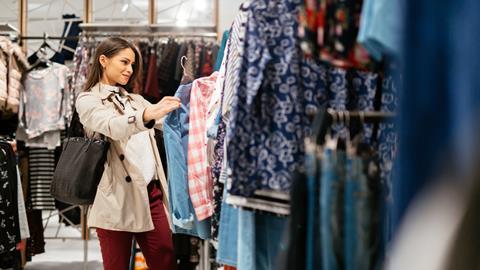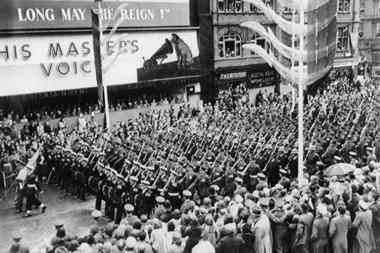As retailers learn the lessons of the pandemic, the future could see a dramatic change in the traditional model, with stockless stores as the way forward, argues Alex MacPherson, director of solution consultancy and account management at Manhattan Associates
We have all seen the headlines and a plethora of statistics about the increase in online shopping over the past 12 months.
The boom in ecommerce is incontrovertible, but what is less clear is the impact the past year will have on traditional high street retailers in the longer term as new consumer behaviour becomes the norm.
Along with the continuing popularity and convenience of ecommerce, health, hygiene and social distancing will continue to be tackled with wariness by consumers, at least for the medium term.
However, in between the various national lockdowns, high street retailers were learning to adapt to the nuances of their new operating backdrops: virtual queueing, kerbside pickup, contactless payment options and even using physical stores as mini fulfilment centres.
‘Trapped’ stock
One of the biggest challenges at the start of the pandemic when stores closed their doors was the issue of in-store goods: lockdown 1.0 saw large volumes of stock trapped in closed high street locations that couldn’t be sold or even reintroduced to the supply chain for ecommerce purposes.
Further down the line, retailers were then forced to sell this stock at huge discounts once stores could reopen. In some cases, inventory was arduously and eventually made available for ecommerce fulfilment – great for consumers’ pockets, but bad for retailers’ balance sheets.
“The more stock held in a store the less accessible and less profitable it is”
Looking ahead, having a smaller volume of inventory within stores will ensure retailers avoid this position again. Furthermore, if customers can’t – or are unwilling to – try on the items they’re looking to buy, is there really any need to have stock in stores at all?
In reality, aside from the safety implications of having multiple customers handle the same item of clothing, the more stock held in a store the less accessible and less profitable it is.
Virtual queueing
Back in the late 1990s, Argos was regarded as unusual for its model – using its stores as mini-distribution centres and only having the goods on display with a ticketing system for purchase.
Now, however, this approach could become the default for many retailers in the future: think virtual queueing systems, increased use of mobile tills to ensure social distancing and stock used for display purposes only.
The disruption of 2020 has made retailers realise that stock located in the ‘wrong’ place greatly impacts sales, profitability and the customer experience. So, why not also use the learnings of the past 12 months as the catalyst to change the whole ‘philosophical’ approach to the physical store?
The face of the high street has been changing for many years now, but the pandemic may well represent the short-term significant shock needed to kick-start a high street renaissance, allowing brands to rethink the best use of their most valuable assets – the bricks-and-mortar square footage of their flagship stores.
High streets must reinvent
The next decade will likely see brands look to reinvent their high street store presence in a move towards more experiential brand experience.
Rather than (effectively) supersized showrooms full of products across all sizes and colours, in the not-so-distant future the traditional shopping trip we once knew may well be completely transformed.
Instead of the multicoloured array of bags seen after a big shopping trip, tomorrow’s shopper may well be bagless.
“Once upon a time, out of stock would have meant out of business – that may not be the case tomorrow”
Racks of clothes could well be replaced by mannequins displaying fashion combinations as shops reduce the levels of goods they hold.
Smart mirrors will allow shoppers to use virtual/augmented reality to try on clothes in a contactless environment.
Shoppers will be able to avoid queues, instead using app-based queueing and mobile point-of-sale technology through iPads and contactless payments.
And, while some stock may be available to take home there and then, more likely it will be delivered on the same or next day to the customer’s home – in effect, a reverse click and collect.
Consumer behaviour has changed over the past 12 months, so approaches to retail and how the high street operates must adapt, too.
Once upon a time, out of stock would have meant out of business. However, that may not be the case tomorrow.
Change is essential
Abstract as it might sound, the backdrop that the retail industry is operating against today means that the less stock a store physically holds, the better off it might be.
If retail is to recover and grow again during the coming years, the way in which physical stores are operated has to change.
The high street as we once knew it isn’t going to return. The important thing is to recognise that this is OK.
With an increased awareness of shifting consumer behaviour, an understanding of the latest applications possible for supply chain and retail technology, and a willingness to think more creatively and innovatively about how best to use valuable floor space, retailers will be able to reinvent the brand experience on offer in their flagship stores, welcoming in a high street renaissance of epic potential.
The future is bright – the future may yet be stockless, too…
Alex MacPherson is director of solution consultancy and account management at Manhattan Associates

McPherson is a seasoned supply chain expert who has been with Manhattan Associates for the past 20 years. In his role, he advises clients on the best supply chain and omnichannel commerce technology solutions to use. Clients include Co-op, Asda and Wilko.































